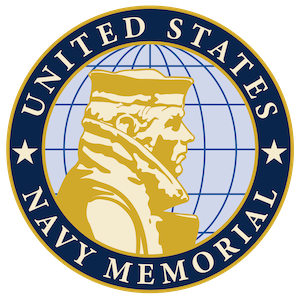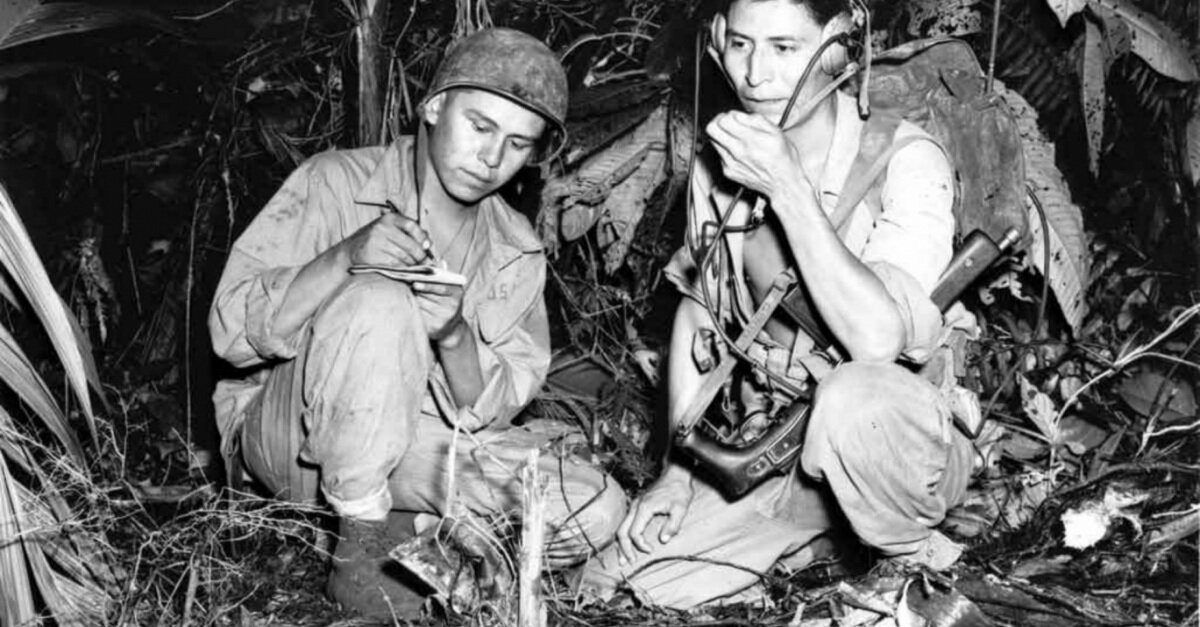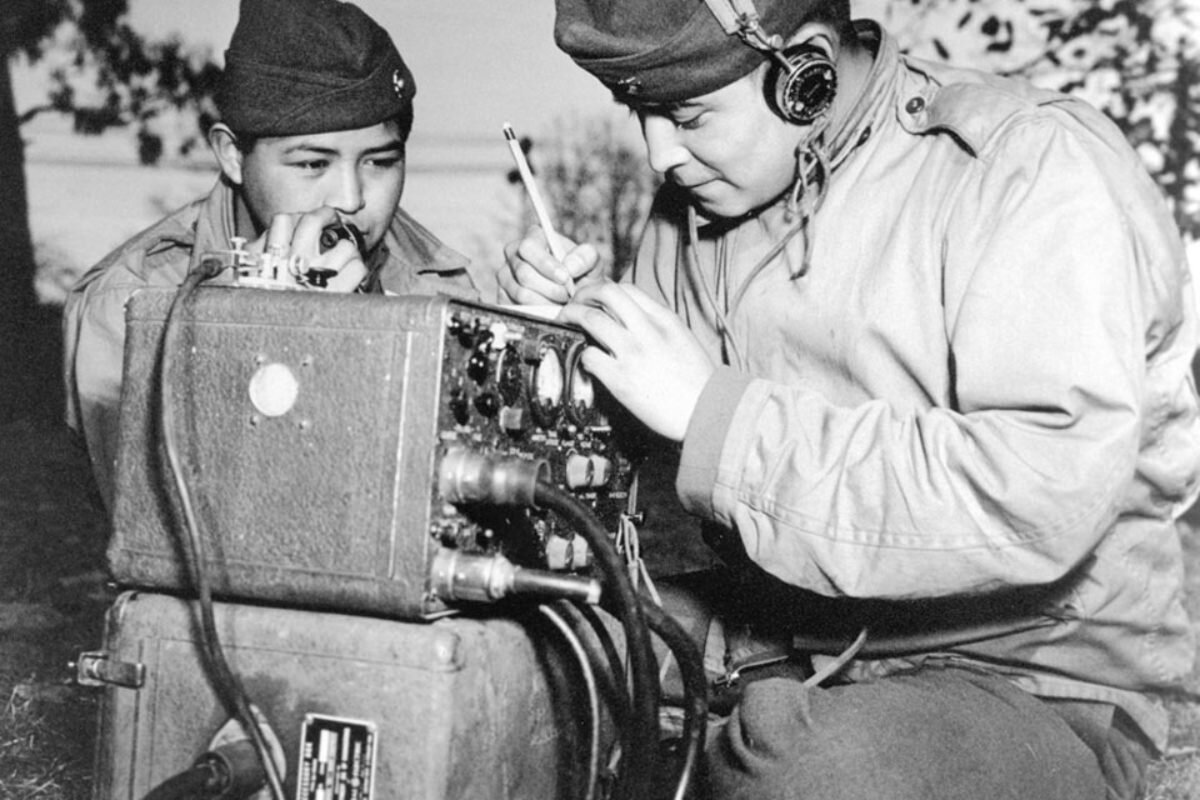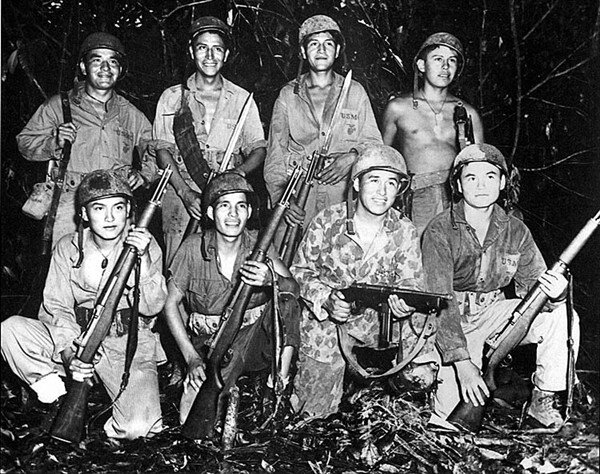Talking Code, Honoring Service: Remembering the Navajo Code Talkers
On August 14, the nation celebrates Navajo Code Talkers Day, a commemorative holiday established in 1982 to recognize the vital contributions of Navajo Code Talkers during World War II. Their devoted service to the nation came at a time when American Indians and their nations and tribes still faced discrimination and legal restrictions, challenges that many continue to face today. On this day, Tales from the Navy Log wants to make sure to highlight some of the Stories of Service from these brave Americans that are forever immortalized in the Navy Log.
Many American Indians served in the military in roles other than as code talkers. One prestigious example of this fact can be seen in the service of CDR Ernest Edwin Evans, who posthumously earned the Medal of Honor for his gallant service in the Battle of Leyte Gulf during World War II. His full citation can be read in his Navy Log.
Throughout the nation’s long history, American Indians have done their part in service to the American armed forces. Through the twentieth century, American Indians did not serve in segregated units, but were instead inducted alongside whites and fought in largely white units. For this reason, there were no separately identifiable American Indian units, and American Indian service records generally listed “white” as their race, so it is difficult to tell how many Native Americans served. Even so, the total number is perhaps 44,000 American Indians to serve in World War II alone, with roughly 550 giving their lives during the war, and over 12,000 American Indians served in the First World War. However, it was in World War I when American Indians were given their first unique role in the military: as “Code Talkers.”
These Choctaw men pose for a picture as they prepare for training as code talkers in World War I. Their meritorious service in this war was instrumental in paving the way for the Navajo code talkers of the Second World War.
In the middle of the battlefield, it is essential for messages to be delivered and received as quickly as possible, and it is even more critical that these messages are encoded so that enemy troops will not be able to intercept them and learn about plans in advance. Officers across Europe during World War I diligently searched for ways to encode the messages they sent through the trenches, and new codes were always in the works just in case the enemy had cracked one system without their knowledge. In the autumn of 1918, as Americans were involved in the Meuse-Argonne Offensive, these fears were realized when German troops successfully tapped Allied telephone lines, deciphered Allied codes, and repeatedly captured Allied messenger runners, jeopardizing the Allies’ abilities to effectively communicate their battle plans and movements. As officers scrambled for an alternative, a solution was revealed in the field by accident. While walking down the battlefield among of his troops, a young captain in the 142nd Infantry Regiment overheard two Choctaw soldiers in his unit having a conversation in their native language. After a brief conversation with these two men, the captain realized the potential of this language in communication and asked if they knew of any other Choctaw soldiers who would also know the language. The captain then asked the two men to deliver a message using a field telephone to company headquarters, where other Choctaw soldiers were stationed. After this brief exchange, the Choctaw Telephone Squad was born and the advent of Code Talking had begun. Within hours, eight Choctaw speakers were dispatched to strategic locations and ordered to communicate messages using the Choctaw language. Choctaw, a language only spoken by a few American Indian tribes and nations and largely unknown outside of these circles, did not cover military terms, so coded words for terms like “machine gun” and “regiment.” The Germans were unable to break this code, and the Choctaw code talkers were instrumental in Allied success in the Meuse-Argonne Offensive, the last offensive of the war. In total, 19 Choctaw soldiers served in the telephone squad. Ironically, while the Choctaw soldiers in France used their language to help win the war, their children were severely punished in Oklahoma for speaking the same language in schools, a cruel irony that certainly was noted by the soldiers abroad. American Indians from several other tribes also used their own native languages and codes to transmit battle messages before the war came to an end, and each of their contributions was essential in realizing Allied victory in World War I.
TSGT Philip Johnston also played a central role in recruiting Navajo men as Code Galkers. He embarked upon a recruiting tour around the Navajo Reservation just east of Flagstaff, Arizona, in October of 1942 to promote the initiative.
When World War II broke out, American commanders were initially skeptical to readopt American Indian troops as Code Talkers for fears that the Germans had been able to learn the language during the interwar years. However, as early as 1940, some Army units began recruiting American Indians in Oklahoma for the explicit purpose of training them as Code Talkers. Comanches, Choctaws, Hopis, Cherokees, and others were brought onboard to send and receive messages using their native languages. Other branches of the military were initially hesitant to do the same, but Philip Johnston, a World War I veteran who grew up on a Navajo reservation in Arizona, convinced them otherwise. Johnston, who had learned some of the Navajo language as a child growing up with native speakers, had seen the complexity of the Navajo language and saw its utility on the battlefield. The language had been little studied or understood by non-speakers, and Johnston knew that it proved challenging to break. In 1942, Johnston suggested to the Marine Corps that Navajos and other tribes could be of great use in communications on the battlefield in the current war. After watching a demonstration of messages sent in the Navajo language, the Marine Corps was so impressed that they immediately organized the recruitment of Navajo men to develop a code with their own language. Initially, 29 Navajo men were recruited to develop this code. The Navajo Code Talkers in the Marine Corps were born. Before long, American Indian men from several other tribes and nations were recruited to perform similar tasks as Code Talkers for other branches of the military, turning the Code Talkers into a vital component of every theater of the war before its conclusion.
Within this image is pictured the 29 original Navajo Code Talkers. These men were charged with converting their native language into a code compatible with military communication demands. The code they devised was used by other Code Talkers through the duration of the war.
To serve as Code Talkers, different men who spoke different Native languages had their own unique challenges to tackle to convey the essential military messages. Several tribal languages used in Code Talking were capable of more direct translations to deliver messages, and these coding systems were called Type Two Codes. In this instance, a Code Talker could simply translate phrases such as “C Company is moving east at 0830 in the morning” or “B Platoon needs more ammunition to their foxholes” directly and then convey them over the radio. Navajo Code Talkers, on the other hand, as well as Code Talkers from the Comanche, Hopi, and Meskwaki tribes, had to develop a special code based on their languages in what came to be known as Type One Codes. To develop their Type One Code, the original 29 Navajo Code Talkers had to assign a Navajo word for each letter of the English alphabet. Since this code would have to be memorized, the men chose words already familiar to them, such as those referencing animals. The English D became the Native word for dog, for example, while O was the word for Owl. Aside from this code, the original 29 also had to develop special words for terms relevant to essential military equipment, including types of planes, ships, and weapons. To develop these code words, the group was given picture charts that showed these essential items, and they developed words that seemed to best fit the picture shown. For example, the Navajo word for eagle was used to represent a transport plane, while a destroyer was coded as a shark, battleship as a whale, cruiser as a small whale, submarines as iron fish, and a carrier as a bird carrier. Comanche, Choctaw, and Hopi Code Talkers similarly developed these code words into their own Type One Codes. Aside from learning these codes, Code Talkers also had to receive proper training in handheld radio and field telephones, along with other signaling equipment and electronic communication lines, to ensure that their messages could be technically transferred no matter what. As Marines, the Navajo Code Talkers received their training at Camp Pendleton in California. With their codes developed and their training completed, Code Talkers increased their numbers and prepared for service on the front lines.
With their training completed, Navajo Code Talkers were sent to the Pacific with their Marine Corps units to send their coded messages on battlefields across the theater. The first Code Talkers in this theater saw service on Guadalcanal, and the program proved incredibly successful, although not without peril for the Code Talkers themselves. Many other Code Talkers fallowed: Hopi Code Talkers were also sent to the Pacific, while other Code Talkers, including Comanches and Meskwakis, served in Europe and North Africa. By the end of the war, Code Talkers from many different tribes served across the globe. While in the field, one Code Talker would operate a portable radio while a second person would relay and receive the messages sent in their Native language and translate them into English. In the field, some Code Talkers were able to translate three lines of English within 20 seconds, as opposed to the common 30 minutes demanded by existing code-breaking machines, saving valuable time on the battlefield and conveying essential messages at lightning speed. Throughout the war, some 420 Navajos served as Code Talkers, the most of any Native group to serve in this role. While in the Pacific, Navajo Code Talkers served heroically under fire and delivered their coded messages no matter what situation they encountered. These men played an instrumental role in the Marine Corps’ success, performing essential duties in battles like Iwo Jima and Okinawa. In reference to their role on Iwo Jima, just six Navajo Code Talkers successfully transmitted over 800 messages without error throughout the duration of the month-long fight. After the battle, a 5th Marine Division signal officer stated that “Were it not for the Navajos, the Marines would never have taken Iwo Jima.” By war’s end, eight Code Talkers were killed. It is believed, though, that their code remained unbroken, an incredible feat that serves as a testament of the gallantry displayed by the men who used in in action.
While in uniform, Code Talkers earned many medals, including Purple Hearts, Silver Stars, Good Conduct Medals, Bronze Stars, and Combat Infantry Badges. However, despite their devoted and heroic service in uniform, national recognition of their service was slow. This discrepancy came perhaps in part from the classified nature of the Code Talkers to defend their codes. The Code Talkers themselves were ordered to keep their exact wartime jobs secret, although they were properly heralded with respect and honor as war heroes in the communities to which they returned. When the Code Talkers program was declassified in 1968, the American people could fully realize the importance of their achievements, and proper recognition finally began to arrive. In 2000, Congress passed legislation to honor the Navajo Code Talkers by providing them with a special gold and silver Congressional Medals. The gold medals were awarded to the original 29 Navajo Code Talkers that developed the code, while the silver medals were presented to those that served later in the program. A statement on the medal read in Navajo: “With the Navajo language they defeated the enemy.” President George W. Bush presented these medals to surviving members and next of kin of the original 29 in a special ceremony at the White House in 2001, during which time he expressed the nation’s gratitude for their heroic service. In 2008, the Code Talkers Recognition Act struck similar gold medals, one for each American Indian tribe that had some of its members serve as Code Talkers during the war.
John Goodluck (bottom row, second from right) poses for a picture with some of his fellow Marines in the field.
Today and always, the Navy Memorial Honors and Celebrates the service of the Navajo Code Talkers, a large number of which are memorialized in the Navy Log. Tales of the Navy Log wants to Celebrate the service of a few of these brave men, the first of which is John V Goodluck, one of the original 29 Navajo Code Talkers. Born in Lukachukai, Arizona, in 1924, Goodluck helped develop the codes that Code Talkers like him used in the field. Goodluck’s long service career took him through action on Guadalcanal, Bougainville, Guam, and Iwo Jima, and his service under intense enemy fire earned him a Combat Action Ribbon. Make sure to view his Navy Log here.
Another Code Talker prominently honored in the Navy Log is Chester Nez. Born in New Mexico, Nez was also one of the original 29 Code Talkers charged with creating the Navajo code. Nez went on to serve on Guadalcanal, Bougainville, Guam, Peleliu, and Angaur. He was also the last of the 29 to alive before he too passed away in 2014, after giving several interviews and publishing a book on his experiences. One of these interviews was given to the Navy Memorial Interview Program, which details his enlistment into the program and his experiences in combat. This interview, which was also conducted alongside his son, also discusses why Nez served a nation that historically showed so much animosity and condemnation towards him because of who he was, an important reminder of the plight that the families of Code Talkers suffered and continue to suffer even as others risk their lives for it. Nez’s fascinating interview can be viewed below:
Part One Joining the Marines and Becoming a Code Talker in 1942
Part Three Memories of Bougainville, Guam, Peleliu, and Angaur
Part Two Memories of a Navajo Code Talker and the Battle of Guadalcanal
Part Four Fighting for the People and Fighting for the Land









